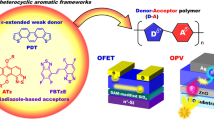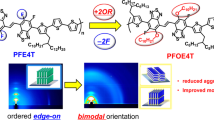Abstract
The development of wide bandgap p-type conjugated polymers to pair with low bandgap nonfullerene n-type acceptors (NFAs) has emerged as an important topic in polymer solar cells. Naphtho[1,2-d:5,6-d’]bis([1,2,3]triazole (NTz), in which the central nitrogen bears an aliphatic side chain, can serve as a mild electron acceptor to generate wide bandgap p-type conjugated polymers. To this end, we synthesized two donor-acceptor alternating copolymers, PBDTNTz1 and PBDTNTz2, based on naphthobistriazole (NTz) as the acceptor and benzodithiophene (BDT) as the donor. The two polymers had optical bandgaps of ca. 1.9 eV with absorption spectra complementary to that of the typical nonfullerene n-type acceptor ITIC. Side-chain engineering was implemented by introducing different combinations of alkyl groups on the BDT and NTz units in PBDTNTz1 and PBDTNTz2. According to theoretical calculations, PBDTNTz1 has higher backbone coplanarity with a face-on π-π stacking orientation. Consequently, a device with the PBDTNTz1:ITIC combination delivered a high PCE of 7.37% with a Voc of 0.94 V, a Jsc of 14.04 mA/cm2 and an FF of 55.8%. In addition, organic field-effect transistors (OFETs) using PBDTNTz1 and PBDTNTz2 exhibited hole mobilities of 2.2 × 10−2 cm2V−1s−1 and 5.0 × 10−2 cm2V−1s−1 with on/off ratios of 1 × 104 and 9 × 102, respectively.
This is a preview of subscription content, access via your institution
Access options
Subscribe to this journal
Receive 12 print issues and online access
$259.00 per year
only $21.58 per issue
Buy this article
- Purchase on Springer Link
- Instant access to full article PDF
Prices may be subject to local taxes which are calculated during checkout









Similar content being viewed by others
References
Chen J, Cao Y. Development of Novel Conjugated Donor Polymers for High-Efficiency Bulk-Heterojunction Photovoltaic Devices. Acc Chem Res. 2009;42:1709–18.
Li Y. Molecular Design of Photovoltaic Materials for Polymer Solar Cells: Toward Suitable Electronic Energy Levels and Broad Absorption. Acc Chem Res. 2012;45:723–33.
Li Y, Zou Y. Conjugated Polymer Photovoltaic Materials with Broad Absorption Band and High Charge Carrier Mobility. Adv Mater. 2008;20:2952–8.
Thompson BC, Frechet JM. Polymer-fullerene Composite Solar Cells. Angew Chem Int Ed. 2008;47:58–77.
Arias AC, MacKenzie JD, McCulloch I, Rivnay J, Salleo A. Materials and Applications for Large Area Electronics: Solution-Based Approaches. Chem Rev. 2010;110:3–24.
Cheng Y-J, Yang SH, Hsu CS. Synthesis of Conjugated Polymers for Organic Solar Cell Applications. Chem Rev. 2009;109:5868–923.
Günes S, Neugebauer H, Sariciftci NS. Conjugated Polymer-Based Organic Solar Cells. Chem Rev. 2007;107:1324–38.
Duan C, Huang F, Cao Y. Recent Development of Push–pull Conjugated Polymers for Bulk-heterojunction Photovoltaics: Rational Design and Fine Tailoring of Molecular Structures. J Mater Chem. 2012;22:10416–34.
Li G, Zhu R, Yang Y. Polymer Solar Cells. Nat Photonics. 2012;6:153–61.
Yu G, Gao J, Hummelen JC, Wudl F, Heeger AJ. Polymer Photovoltaic Cells: Enhanced Efficiencies via a Network of Internal Donor-Acceptor Heterojunctions. Science. 1995;270:1789–91.
He C, Chen Z, Wang T, Shen Z, Li Y, Zhou J, et al. Asymmetric electron acceptor enables highly luminescent organic solar cells with certified efficiency over 18. Nat Commun. 2022;13:2598.
Yan C, Barlow S, Wang Z, Yan H, Jen AKY, Marder SR, et al. Non-fullerene acceptors for organic solar cells. Nat Rev Mater. 2018;3:18003.
Cheng P, Li G, Zhan X, Yang Y. Next-generation organic photovoltaics based on non-fullerene acceptors. Nat Photonics. 2018;12:131–42.
Kang H, Lee W, Oh J, Kim T, Lee C, Kim BJ. From Fullerene–Polymer to All-Polymer Solar Cells: The Importance of Molecular Packing, Orientation, and Morphology Control. Acc Chem Res. 2016;49:2424–34.
Kim T, Kim J-H, Kang TE, Lee C, Kang H, Shin M, et al. Flexible, highly efficient all-polymer solar cells. Nat Commun. 2015;6:8547.
Liu F, Zhou Z, Zhang C, Vergote T, Fan H, Liu F, et al. A Thieno[3,4-b]thiophene-Based Non-fullerene Electron Acceptor for High-Performance Bulk-Heterojunction Organic Solar Cells. J Am Chem Soc. 2016;138:15523–6.
Li Z, Jiang K, Yang G, Lai JYL, Ma T, Zhao J, et al. Donor polymer design enables efficient non-fullerene organic solar cells. Nat Commun. 2016;7:13094.
Zheng Z, Awartani OM, Gautam B, Liu D, Qin Y, Li W, et al. Efficient Charge Transfer and Fine-Tuned Energy Level Alignment in a THF-Processed Fullerene-Free Organic Solar Cell with 11.3% Efficiency. Adv Mater. 2017;29:1604241.
Nielsen CB, Holliday S, Chen H-Y, Cryer SJ, McCulloch I. Non-Fullerene Electron Acceptors for Use in Organic Solar Cells. Acc Chem Res. 2015;48:2803–12.
Zhao W, Li S, Yao H, Zhang S, Zhang Y, Yang B, et al. Molecular Optimization Enables over 13% Efficiency in Organic Solar Cells. J Am Chem Soc. 2017;139:7148–51.
Lin H, Chen S, Li Z, Lai JYL, Yang G, McAfee T, et al. High-Performance Non-Fullerene Polymer Solar Cells Based on a Pair of Donor–Acceptor Materials with Complementary Absorption Properties. Adv Mater. 2015;27:7299–304.
Xue YJ, Cao FY, Huang PK, Su Y-C, Cheng Y-J. Isomeric effect of fluorene-based fused-ring electron acceptors to achieve high-efficiency organic solar cells. J Mater Chem A. 2020;8:5315–22.
Cao FY, Huang WC, Chang SL, Cheng YJ. Angular-Shaped 4,9-Dialkylnaphthodithiophene-Based Octacyclic Ladder-Type Non-Fullerene Acceptors for High Efficiency Ternary-Blend Organic Photovoltaics. Chem Mater. 2018;30:4968–77.
Cao FY, Huang PK, Su YC, Huang WC, Chang SL, Hung KE, et al. Forced coplanarity of dithienofluorene-based non-fullerene acceptors to achieve high-efficiency organic solar cells. J Mater Chem A. 2019;7:17947–53.
Yuan J, Zhang Y, Zhou L, Zhang G, Yip H-L, Lau T-K, et al. Single-Junction Organic Solar Cell with over 15% Efficiency Using Fused-Ring Acceptor with Electron-Deficient Core. Joule. 2019;3:1140–51.
Hong L, Yao H, Wu Z, Cui Y, Zhang T, Xu Y, et al. Eco-Compatible Solvent-Processed Organic Photovoltaic Cells with Over 16% Efficiency. Adv Mater. 2019;31:1903441.
Li K, Wu Y, Tang Y, Pan M-A, Ma W, Fu H, et al. Ternary Blended Fullerene-Free Polymer Solar Cells with 16.5% Efficiency Enabled with a Higher-LUMO-Level Acceptor to Improve Film Morphology. Adv Energy Mater. 2019;9:1901728.
Lin Y, Adilbekova B, Firdaus Y, Yengel E, Faber H, Sajjad M, et al. 17% Efficient Organic Solar Cells Based on Liquid Exfoliated WS2 as a Replacement for PEDOT:PSS. Adv Mater. 2019;31:1902965.
Ma X, Zeng A, Gao J, Hu Z, Xu C, Son JH, et al. Approaching 18% efficiency of ternary organic photovoltaics with wide bandgap polymer donor and well compatible Y6: Y6-1O as acceptor. Natl Sci Rev. 2020;8:nwaa305.
Liu Q, Jiang Y, Jin K, Qin J, Xu J, Li W, et al. 18% Efficiency organic solar cells. Sci Bull. 2020;6:272–5.
Zhang T, An C, Bi P, Lv Q, Qin J, Hong L, et al. A Thiadiazole‐Based Conjugated Polymer with Ultradeep HOMO Level and Strong Electroluminescence Enables 18.6% Efficiency in Organic Solar Cell. Adv Energy Mater. 2021;11:2101705.
Hong L, Yao H, Cui Y, Bi P, Zhang T, Cheng Y, et al. 18.5% Efficiency Organic Solar Cells with a Hybrid Planar/Bulk Heterojunction. Adv Mater. 2021;33:2103091.
Zhang L, Zhang Z, Deng D, Zhou H, Zhang J, Wei Z “N-pi-N” Type Oligomeric Acceptor Achieves an OPV Efficiency of 18.19% with Low Energy Loss and Excellent Stability. Adv Sci. 2022;2202513.
Fan B, Zhu P, Xin J, Li N, Ying L, Zhong W, et al. High-Performance Thick-Film All-Polymer Solar Cells Created Via Ternary Blending of a Novel Wide-Bandgap Electron-Donating Copolymer. Adv Energy Mater. 2018;8:1703085.
Yao H, Cui Y, Yu R, Gao B, Zhang H, Hou J. Design, Synthesis, and Photovoltaic Characterization of a Small Molecular Acceptor with an Ultra-Narrow Band Gap. Angew Chem Int Ed Engl. 2017;56:3045–9.
Gao L, Zhang ZG, Xue L, Min J, Zhang J, Wei Z, et al. All-Polymer Solar Cells Based on Absorption-Complementary Polymer Donor and Acceptor with High Power Conversion Efficiency of 8.27%. Adv Mater. 2016;28:1884–90.
Lin Y, Zhao F, Prasad SKK, Chen JD, Cai W, Zhang Q, et al. Balanced Partnership between Donor and Acceptor Components in Nonfullerene Organic Solar Cells with >12% Efficiency. Adv Mater. 2018;30:e1706363.
Yang Y, Zhang ZG, Bin H, Chen S, Gao L, Xue L, et al. Side-Chain Isomerization on an n-type Organic Semiconductor ITIC Acceptor Makes 11.77% High Efficiency Polymer Solar Cells. J Am Chem Soc. 2016;138:15011–8.
Bin H, Zhong L, Yang Y, Gao L, Huang H, Sun C, et al. Medium Bandgap Polymer Donor Based on Bi(trialkylsilylthienyl-benzo[1,2-b:4,5-b′]-difuran) for High Performance Nonfullerene Polymer Solar Cells. Adv Energy Mater 2017;7:1700746.
Bin H, Zhang ZG, Gao L, Chen S, Zhong L, Xue L, et al. Non-Fullerene Polymer Solar Cells Based on Alkylthio and Fluorine Substituted 2D-Conjugated Polymers Reach 9.5% Efficiency. J Am Chem Soc. 2016;138:4657–64.
Min J, Zhang Z-G, Zhang S, Li Y. Conjugated Side-Chain-Isolated D–A Copolymers Based on Benzo[1,2-b:4,5-b′]dithiophene-alt-dithienylbenzotriazole: Synthesis and Photovoltaic Properties. Chem Mater. 2012;24:3247–54.
Bin H, Gao L, Zhang ZG, Yang Y, Zhang Y, Zhang C, et al. 11.4% Efficiency non-fullerene polymer solar cells with trialkylsilyl substituted 2D-conjugated polymer as donor. Nat Commun. 2016;7:13651.
Gao L, Zhang ZG, Bin H, Xue L, Yang Y, Wang C, et al. High-Efficiency Nonfullerene Polymer Solar Cells with Medium Bandgap Polymer Donor and Narrow Bandgap Organic Semiconductor Acceptor. Adv Mater. 2016;28:8288–95.
Osaka I, Takimiya K. Naphthobischalcogenadiazole Conjugated Polymers: Emerging Materials for Organic Electronics. Adv Mater. 2017;29:1605218.
Dong Y, Hu X, Duan C, Liu P, Liu S, Lan L, et al. A series of new medium-bandgap conjugated polymers based on naphtho[1,2-c:5,6-c]bis(2-octyl-[1,2,3]triazole) for high-performance polymer solar cells. Adv Mater. 2013;25:3683–8.
Tang D, Wan J, Xu X, Lee YW, Woo HY, Feng K, et al. Naphthobistriazole-based wide bandgap donor polymers for efficient non-fullerene organic solar cells: Significant fine-tuning absorption and energy level by backbone fluorination. Nano Energy. 2018;53:258–69.
Feng K, Yuan J, Bi Z, Ma W, Xu X, Zhang G, et al. Low-Energy-Loss Polymer Solar Cells with 14.52% Efficiency Enabled by Wide-Band-Gap Copolymers. iScience. 2019;12:1–12.
Lan L, Zhang G, Dong Y, Ying L, Huang F, Cao Y. Novel medium band gap conjugated polymers based on naphtho[1,2-c:5,6-c]bis[1,2,3]triazole for polymer solar cells. Polymer. 2015;67:40–6.
Osaka I, Takimiya K. Backbone orientation in semiconducting polymers. Polymer. 2015;59:1–15.
Acknowledgements
We thank the National Science and Technology council and the Ministry of Education, and Center for Emergent Functional Matter Science, Yang Ming Chiao Tung University, Taiwan, for financial support. We thank the National Center of High-performance Computing (NCHC) in Taiwan for computer time and facilities. We also thank the National Synchrotron Radiation Research Center (NSRRC) in Taiwan and Dr. U-Ser Jeng and Dr. Chun-Jen Su at the BL23A1 station for their help with the GIWAXS measurements.
Author information
Authors and Affiliations
Corresponding author
Ethics declarations
Conflict of interest
The authors declare no confict of interest.
Additional information
Publisher’s note Springer Nature remains neutral with regard to jurisdictional claims in published maps and institutional affiliations.
Supplementary information
Rights and permissions
Springer Nature or its licensor (e.g. a society or other partner) holds exclusive rights to this article under a publishing agreement with the author(s) or other rightsholder(s); author self-archiving of the accepted manuscript version of this article is solely governed by the terms of such publishing agreement and applicable law.
About this article
Cite this article
Cao, FY., Hsu, JY., Hung, KE. et al. Synthesis of naphtho[1,2-d:5,6-d']bis([1,2,3]triazole)-based wide-bandgap alternating copolymers for polymer solar cells and field-effect transistors. Polym J 55, 417–426 (2023). https://doi.org/10.1038/s41428-022-00742-9
Received:
Revised:
Accepted:
Published:
Issue Date:
DOI: https://doi.org/10.1038/s41428-022-00742-9



